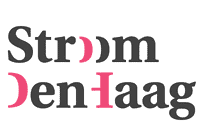Jos Kruit, Zonder titel, 2007 foto: Sander Foederer, courtesy Stroom Den Haag
Jos Kruit, (no title), 2007
Jos Kruit, Untitled, 2007
Location: Center of The Hague: Spui - Grote Marktstraat - Kalvermarkt
The first sculptures by Jos Kruit (1945) were made of barbed wire held together with cow intestines. She gained national recognition in a single leap in 1994 when Rudi Fuchs, then director of the Stedelijk Museum in Amsterdam, included two of her works in the exhibition 'Couplet II'. The transparent 'Horse Cathedral' became the most well-known. This spatial sculpture was constructed from eighteen pinkish-red, elongated horse legs made of resin. The legs were grouped in pairs and then connected into domes with steel tubes. The inner dome's legs are extended while the outer legs are bent, giving the sculpture a peculiar twist.
Like the 'Horse Cathedral,' Kruit's other sculptures also possess great spatial quality. Additionally, this sculptor is always seeking movement and balance in her work. This is true for her pedestal sculpture as well. It features an open construction that gives the impression of something rotating within the space of the pedestal. Identifying what the pedestal sculpture represents is not easy. Nevertheless, it is recognizable from a distance. On the pedestal stands a slightly tilted, sand-colored cylindrical casing that is open on one side. The exterior is smoothly polished, evoking thoughts of car hoods and airplanes. Inside the casing, against a matte interior wall, you can discern a steering wheel on a tall pole. Both the wheel and the pole are painted to look like wood. Associations with ship's steering wheels and masts immediately come to mind. Yet, the overall appearance of the sculpture does not resemble anything concrete. Kruit took Geert Lap's pedestal as a starting point for her sculpture. The sculpture is, for example, twice as long and half open. For Kruit, it primarily concerns proportions, surface, material, spatiality, and movement. In short, her pedestal sculpture is a true sculptor's work.


